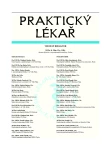Prevalence and socioeconomic consequences of overactive bladder symptoms
Authors:
M. Záleský; R. Zachoval
Authors‘ workplace:
Fakultní Thomayerova nemocnice s poliklinikou, Praha
; Primář: Doc. MUDr. Roman Zachoval, Ph. D.
; Urologické oddělení
Published in:
Prakt. Lék. 2009; 89(6): 312-316
Category:
Of different specialties
Overview
Aim:
The aim of the review is to summarize the information available on the prevalence of overactive bladder symptoms, the consequences for patients’ quality of life and consequences for the community.
Methods:
Mesh terms „prevalence overactive bladder“ or „overactive bladder costs“ were searched in Medline database. Information retrieved from the articles found was used for this overview.
Results:
Prevalence of overactive bladder symptoms is 11–18 %. Prevalence rises with age. There is no major difference between the overall prevalence of OAB in men and women, although among women, OAB causes urgent urinary incontinence more often than in men. In most of patients OAB has a serious impact on quality of life. OAB occurs together with depression in some patients. In elderly patients OAB increases the risk of falls and fractures. Direct and indirect costs caused by OAB are considerable.
Conclusion:
According to large population studies, the prevalence of OAB is higher than that of other common chronic disease such as diabetes or hypertension. However the number of actually diagnosed and treated patients with OAB is much lower. From this point of view OAB is an underdiagnosed and undertreated disease in population.
Key words:
overactive bladder, urgency, epidemiology, costs.
Sources
1. Abrams, P., Andersson, K.E. Muscarinic receptor antagonists for overactive bladder. BJU Int. 2007, 100, 5, p. 987-1006.
2. Abrams, P., Blaivas, J.G., Stanton, S.L., Andersen, J.T. The standardisation of terminology of lower urinary tract function. The International Continence Society Committee on Standardisation of Terminology. Scand. J. Urol. Nephrol. Suppl. 1988, 114, p. 5-19.
3. Abrams, P., Cardozo, L., Fall, M. et al. The standardisation of terminology of lower urinary tract function: report from the Standardisation Sub-committee of the International Continence Society. Neurourol. Urodyn. 2002, 21, 2, p. 167-78.
4. Abrams, P., Kelleher, C.J., Kerr, L.A., Rogers, R.G. Overactive bladder significantly affects quality of life. Am. J. Manag. Care 2000, 6, 11 Suppl., p. S580-590.
5. Brown, J.S., McGhan, W.F., Chokroverty, S. Comorbidities associated with overactive bladder. Am. J. Manag. Care 2000, 6, 11 Suppl., p. S574-579.
6. Brown, J.S., Vittinghoff, E., Wyman, J.F. et al. Urinary incontinence: does it increase risk for falls and fractures? Study of Osteoporotic Fractures Research Group. J. Am. Geriatr. Soc. 2000, 48, 7, p. 721-725.
7. Corcos, J., Schick, E. Prevalence of overactive bladder and incontinence in Canada. Can. J. Urol. 2004, 11, 3, p. 2278-2284.
8. Homma, Y., Yamaguchi, O., Hayashi, K. An epidemiological survey of overactive bladder symptoms in Japan. BJU Int. 2005, 96, 9, p. 1314-1318.
9. Hu, T.W., Wagner, T.H. Health-related consequences of overactive bladder: an economic perspective. BJU Int. 2005, 96, Suppl. 1, p. 43-45.
10. Hu, T.W., Wagner, T.H., Bentkover, J.D. et al. Estimated economic costs of overactive bladder in the United States. Urology 2003, 61, 6, p. 1123-1128.
11. Irwin, D.E., Milsom, I., Hunskaar, S. et al. Population-based survey of urinary incontinence, overactive bladder, and other lower urinary tract symptoms in five countries: results of the EPIC study. Eur. Urol. 2006, 50, 6, p. 1306-1314; discussion 1314-1315.
12. Kelleher, C.J. Economic and Social Impact of OAB. European Urology Suppl. 2002, 1, 4, p. 11-16.
13. Kelleher, C.J., Cardozo, L.D., Khullar, V., Salvatore, S. A new questionnaire to assess the quality of life of urinary incontinent women. Br. J. Obstet. Gynaecol. 1997, 104, 12, p. 1374-1379.
14. Malone-Lee, J., Henshaw, D.J., Cummings, K. Urodynamic verification of an overactive bladder is not a prerequisite for antimuscarinic treatment response. BJU Int. 2003, 92, 4, p. 415-417.
15. Milsom, I., Abrams, P., Cardozo, L. et al. How widespread are the symptoms of an overactive bladder and how are they managed? A population-based prevalence study. BJU Int. 2001, 87, 9, p. 760-766.
16. Ouslander, J.G. Management of overactive bladder. N. Engl. J. Med. 2004, 350, 8, p. 786-799.
17. Stewart, W.F., Van Rooyen, J.B., Cundiff, G.W. et al. Prevalence and burden of overactive bladder in the United States. World J. Urol. 2003, 20, 6, p. 327-336.
18. Temml, C., Heidler, S., Ponholzer, A., Madersbacher, S. Prevalence of the overactive bladder syndrome by applying the International Continence Society definition. Eur. Urol. 2005, 48, 4, p. 622-627.
19. Zorn, B.H., Montgomery, H., Pieper, K. et al. Urinary incontinence and depression. J. Urol. 1999, 162, 1, p. 82-84.
Labels
General practitioner for children and adolescents General practitioner for adultsArticle was published in
General Practitioner

2009 Issue 6
Most read in this issue
- Health problems related to drug abuse, possibility of prevention in primary care
- Errors in the treatment of delirium tremens
- Syndrome of combined pulmonary fibrosis and emphysema – CPFE syndrome
- Painful foot
